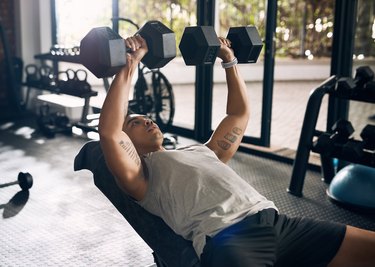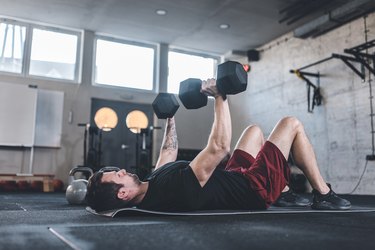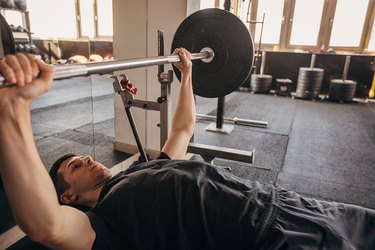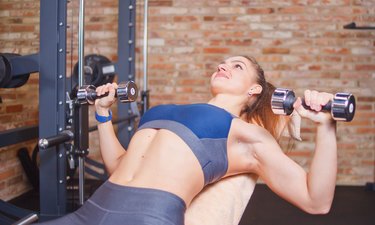
Many gym goers think the barbell bench press should be their go-to move to build a powerful, muscular upper body. But the humble dumbbell bench press can also help you get really strong — and might even be better for building muscle.
- What is the dumbbell bench press? The dumbbell bench press is an upper body pressing exercise where you lie on a bench and push weights above your chest.
- What is it good for? This versatile exercise can help you get stronger, build muscle and improve joint stability.
- What muscles does the dumbbell bench press work? The primary muscles worked during dumbbell bench presses are your pectorals, anterior deltoids and triceps. Your core, lower body and upper back muscles also play a secondary stabilizing role.
- Who can do it? Most people can perform DB bench presses, although they can be contraindicated if you have trouble lying on your back. If you have a history of shoulder or elbow injuries, consult your doctor or physical therapist.
Video of the Day
Let's dive in to why you should do this awesome exercise, plus tips on how to perform, modify and program it.
How to Dumbbell Bench Press With Perfect Form
- Sit on the edge of a bench. Place a dumbbell upright on each thigh.
- Use your legs to help push the weights up to your chest as you carefully lie back onto the bench. A spotter can also hand you the weights.
- At the start of each rep, your arms should be fully extended above your chest. Keep your feet flat on the floor. If you can't, place weight plates or blocks underneath your feet.
- Lower your elbows down toward the floor in a controlled manner. Keep your hands and elbows at a 45-degree angle from your sides.
- Lower the weights to chest height, then finish the rep by driving them back up toward the ceiling until your elbows are fully extended.
5 Benefits of the Dumbbell Bench Press
1. Builds Upper-Body Strength
The bench press is one of the gold standard exercises for building a strong upper body. While you can bench more weight with a barbell, the dumbbell bench press can get you seriously strong. In fact, a small July 2017 study in the Journal of Strength and Conditioning Research found that that dumbbell bench press elicited more activity in both the pectoralis major and biceps muscles than the barbell bench press.
2. Builds Upper-Body Muscle
The dumbbell bench press can be a better chest builder than the barbell bench press. One reason is that the dumbbell bench press uses a larger range of motion, placing greater tension and stretch on your pectoral muscles. Getting to the point where you're pressing a lot of weight can also pack on muscle in your triceps and shoulders.
3. Shoulder-Friendly
Unlike the dumbbell bench press, the barbell bench press locks you into a single bar path and forces you to use a pronated grip. By contrast, the DB bench press allows for much greater freedom of movement.
You can use different grips or rotate your hands throughout the set. You can also easily manipulate the range of motion or change the path of the dumbbells. This means people with cranky shoulders often have an easier time finding a pressing position that works for them.
4. Strengthens Stabilizing Muscles
Holding a weight in each hand forces you to use more of the smaller stabilizing muscles in your arms and shoulders, such as the muscles of the rotator cuff. Strengthening these muscles helps keep your joints healthy.
5. More Adaptable
Not everyone has access to barbells, but nearly all gyms have a dumbbell rack. The DB bench press is a more accessible pressing option for people who train at hotel gyms, home gyms or gyms with less strength equipment.
It's also easier to load by yourself, whereas getting super heavy with the barbell often requires a spotter.
5 Common Form Mistakes
1. Incorrect Elbow Position
It's common to allow your elbows to flare out away from your sides or drift up toward your shoulders when performing the dumbbell bench. This limits how much weight you can lift and can also lead to discomfort in the shoulders, elbows or wrists.
Your elbows should stay beneath your wrists during your entire rep. This stacked position protects your joints and puts you in the strongest possible pressing position.
It's also important to keep your elbows within 45 to 60 degrees of your sides. Your body should look like an arrow when viewed from the side, as opposed to the letter T.
2. Incomplete Range of Motion
One reason why the dumbbell bench press is so great for building muscle is that it allows for a large range of motion. But you won't be able to enjoy this benefit if you sell yourself short and don't lower the dumbbells far enough. Most people should lower the dumbbells until they're just above their chest.
3. Lowering the Dumbbells Too Far
It's also possible to lower the weights too far. You don't want the front part of your shoulder to rotate forward as you lower the dumbbells, as this places extra stress on a vulnerable part of your shoulder. Keep your shoulder blades pulled back and down on the bench and stop your descent before this rotation occurs.
4. Wrist Extension
It's important to grip your dumbbells with a neutral (straight) wrist. Watch out for wrists that curl backward with palms facing the ceiling. Grab the dumbbells so that the handles sit on the lower part of your palm just above your thumb, as opposed to up higher by your fingers. Get a firm grip on the handles and squeeze tightly to keep them in position.
5. Not Using Your Legs
Even though you're primarily using your upper-body muscles, the dumbbell bench press should be a full-body exercise. Focus on driving your legs hard into the ground as you press (although not so hard that your butt pops off the bench.)
If you're shorter, you may need to place small boxes or bumper plates under your feet if the bench is too high off the ground for proper leg drive.
4 Dumbbell Bench Press Variations
1. Dumbbell Floor Press
All you need to perform the dumbbell floor press is a set of dumbbells and a place to lie down. It's a perfect solution for those busy gym days when you can't find an open bench, or if you struggle with the full range of motion when on a bench.
- Sit upright on the floor with your legs extended straight out in front of you and a pair of dumbbells at your sides. Place dumbbells upright on each thigh.
- Keeping the weights close to your chest, lie backwards until your back is flat on the floor. You can use your knees to help push the weights into position.
- Bend your knees and plant your feet on the floor.
- Your upper arms, from shoulders to elbows, should be flat on the floor. Keep your elbows around 45 degrees from your sides. Keep your wrists above your elbows.
- Press the dumbbells up away from your chest until your elbows are fully extended.
- Finish the rep by lowering your arms all the way back to the floor in a controlled manner.
- When you're done with the set, lower the dumbbells to the floor before sitting up.
2. Dumbbell Incline Bench Press
The incline bench press targets the upper portion of your chest and places greater demands on your shoulders than the flat bench press.
- Sit on the edge of a bench. The bench should be at a 30- to 45-degree angle. Place a dumbbell upright on each thigh.
- Use your legs to help push the weights up to your chest as you carefully lie back onto the bench. A spotter can also hand you the weights.
- At the start of each rep, your arms should be fully extended above your chest. Keep your feet flat on the floor. If you can't, place weight plates or blocks underneath your feet.
- Lower your elbows down toward the floor in a controlled manner. Keep your hands and elbows at a 45-degree angle from your sides.
- Lower the weights to chest height, then finish the rep by driving them back up to the ceiling until your elbows are fully extended.
3. Alternating Dumbbell Bench Press
Looking to increase muscular endurance, or make the DB bench press harder without needing heavy weights? The alternating bench press is a great option. Alternating makes your set last longer so you'll feel more challenged with less weight.
- Sit on the edge of a bench. Place a dumbbell upright on each thigh.
- Use your legs to help push the weights up to your chest as you carefully lie back onto the bench. A spotter can also hand you the weights.
- At the start of each rep, your arms should be fully extended above your chest. Keep your feet flat on the floor. If you can't, place weight plates or blocks underneath your feet.
- Lower one elbow down toward the floor in a controlled manner. Keep your moving hand and elbow at a 45-degree angle from your side. The other arm should remain fully extended above your chest.
- Lower the dumbbell to chest height, then finish the rep by driving it back up toward the ceiling until your elbow is fully extended. Repeat on the other side.
4. One-Arm Dumbbell Bench Press
Although the one-arm DB bench press seems like it would be easier than pressing with both arms, it's actually a harder progression. That's because your core muscles must work harder to resist rotation as you lower the dumbbell to one side.
- Sit on the edge of a bench. Place one dumbbell on top of your thigh.
- Lie back onto the bench and use both hands to push the weight overhead. Be careful when you take your second hand off the dumbbell. A spotter can also hand you the weight.
- At the start of each rep, both arms should be fully extended above your chest. Make a fist with the empty hand and keep it there throughout the set. Keep your feet flat on the floor. If you can't, place weight plates or blocks underneath your feet.
- Lower the elbow with the dumbbell down toward the floor in a controlled manner. Keep your hand and elbow at a 45-degree angle from your side. Do not allow your body to rotate on the bench as you lower the weight.
- Lower the weight to chest height, then finish the rep by driving it back up to the ceiling until your elbow is fully extended.
3 Alternatives
1. Push-Ups
Push-ups, like dumbbell bench presses, are a horizontal pressing exercise. The biggest difference is that you press your own bodyweight instead of weights. Push-ups also allow for greater freedom of movement of your shoulder blades and might be a more shoulder-friendly option for some, though it's not as beginner-friendly.
- Begin in a push-up position plank with hands on the floor just outside your shoulders. Your arms and legs should be fully extended. Point your belt buckle to your chin to lock in your core position.
- Pull yourself down toward the floor and slightly forward. Keep your elbows within 45 degrees of your sides and maintain your plank position.
- Lower yourself until your chest is about an inch off the floor. Then, push back up until your arms are fully extended.
2. Chest Press Machine
The seated chest press machine might be a better pressing option if you struggle with getting up and down from your back.
Many gyms have several different chest press machines using different angles. Experiment to find which ones work best for your body.
- Adjust the seat on the machine so you can sit comfortably with your feet flat on the floor. The seat should be high enough that you can press without shrugging your shoulders.
- Select your weights on the machine and sit down. Place your hands on the handles and bring your hands forward so they're just in front of your armpits.
- Press out until your elbows are fully extended.
- Finish the rep by bringing your hands back to your chest in a controlled manner.
3. Half-Kneeling One-Arm Overhead Press
If you are not comfortable with any horizontal pressing, you can swap in some type of overhead press.
Begin pressing with just one arm because it requires less upper-body mobility. The half-kneeling one-arm press is a great option if you're new to overhead pressing. In time, try progressing to alternating or bilateral overhead press variations.
- Half kneel on the ground or a mat, with one knee down on the ground directly beneath your hip. The other foot should be in front of you so your front knee forms a 90 degree angle. Dig your back toes into the ground behind you.
- Hold a dumbbell in one hand, your palm facing slightly in toward your midline. Your elbow should be down by your side and your forearm should be vertical. If your left knee is down the dumbbell should be in your left hand (or vice versa.)
- Make a fist with your empty hand and keep it out by your side throughout the set.
- Press the weight up to the ceiling. Allow your arm and hand to naturally rotate as you press. Do not shrug your shoulder or arch your back as you press.
- Lower the weight back down in a controlled manner until your elbow is once again even with your side. Complete for 5 reps before switching sides.
Frequently Asked Questions
1. How Heavy Should I Dumbbell Bench Press?
If you're just starting out, be conservative and start with light weights. You will eventually be able to go much heavier if you keep training consistently.
Do not assume that your dumbbell bench press will be equal to your barbell bench press. Because of the increased stability demands, you will almost certainly bench less weight when using dumbbells.
2. Is It Better to Bench Press With Dumbbells or Barbells?
Both options have pros and cons. Barbell bench pressing allows you to go heavier and potentially build more strength, but it might not be the best option if your main goal is gaining muscle or if you struggle with shoulder issues. You can choose to pick one or the other, or use them both.
3. Why Can I Bench Less With Dumbbells?
Holding a weight in each hand means your smaller stabilizer muscles must work harder as you press. This is why you won't be able to bench as much weight with two dumbbells as you would with a single barbell.
4. How Many Sets and Reps Should I Do?
Your ultimate goal will determine your set and rep scheme.
- To build strength: Perform heavy sets of 3 to 6 reps.
- To build muscle: Use moderately heavy sets of 6 to 12 reps.
- Muscular endurance: Do lighter, longer sets of 10 to 15 reps.
Perform 2 to 5 total sets depending on how much time you have to train.
5. What if the DB Bench Press Hurts My Shoulders?
Start by lowering the weight. Then, make sure your form is locked in. Keep your elbows stacked beneath your wrists and about 45 to 60 degrees from your side. Don't lower the weights so far that the front part of your shoulder rounds forward.
You may also find that pressing with a neutral (palms in) grip feels better on your shoulders. This is especially important in the bottom of the press when your shoulders are at their most vulnerable position.





